Cheek Fillers
Cheek fillers are among the most popular non-invasive cosmetic procedures performed at Dr. Michele Green’s New York City dermatology office. When fillers are injected into the cheeks, they increase or replenish cheek volume, enhance the definition of bone structure, stimulate new collagen production, and eliminate other signs of aging. Over time, the cheek area can appear hollowed or wrinkled because of loss of collagen and volume. Collagen is an essential structural component in the skin, providing a foundation for a supple, firm, youthful-looking complexion and diminishing fine lines and wrinkles. Cheek filler treatments are one of the most highly sought-after cosmetic procedures for achieving facial rejuvenation for patients who do not want invasive plastic surgery.
The most popular dermal fillers for cheek augmentation are made of hyaluronic acid (HA), like Juvederm and Restylane. Hyaluronic acid fillers provide immediate, natural-looking results with few potential side effects. Other common dermal fillers, such as Sculptra and Radiesse, stimulate collagen to improve the appearance of the midface. Due to their non-invasive nature, cheek fillers can easily be combined with other non-surgical cosmetic procedures to target various signs of aging in a single appointment. Dr. Green utilizes many types of fillers, including Juvederm, Restylane, and Sculptra, to provide her patients with customized treatment plans that result in ideal facial rejuvenation results and a natural-looking youthfulness.
Dr. Michele Green is an internationally renowned board-certified dermatologist with over two and a half decades of experience providing some of the best non-invasive cosmetic procedures, including dermal fillers. Regarding facial rejuvenation, Dr. Green takes a holistic approach and embraces a less-is-more philosophy, customizing each patient’s treatment plan to suit their particular skin concerns and desired results. She is consistently identified as one of New York’s best physicians by Castle Connolly, Super Doctors, and New York Magazine for her dedication to her patients and expertise.
What are cheek fillers?
Facial fillers are injectables used for the enhancement of facial contours, the augmentation of certain features, the replenishment of volume loss, and the provision of a more youthful appearance. Cheek fillers are injected into the midface and cheek area to increase cheek volume, enhance the appearance of the cheekbones, and eliminate signs of aging such as marionette lines, nasolabial folds, and other facial fine lines. Each filler has a unique composition for the different augmentations. The unique components of the fillers are Hyularaunic Acid, poly-L-lactic acid, and Calcium hydroxylapatite. An expert injector, like Dr. Michele Green in NYC, will select the best cheek fillers for your facial rejuvenation plan depending on your facial anatomy, particular skin concerns, and personal aesthetic goals. This allows for a completely customizable approach and long-lasting, natural-looking results.
To guarantee safety, efficacy, and optimal cosmetic results, your cheek filler treatment must be performed by an experienced injector with the knowledge and expertise required to select the most appropriate dermal filler products for your individual treatment. Dr. Green is an expert injector and board-certified dermatologist with over 25 years of experience providing her patients with the best cosmetic injectables NYC offers.
What does cheek filler do?
Cheek fillers are used to replenish facial volume, enhance the definition of the facial bone structure, provide a lifting effect to the midface, reduce fine lines, and give an overall more youthful appearance. Loss of volume in the midface and the cheek area is often one of the first signs of aging and can cause a tired, gaunt look. Cheek fillers can reduce these signs of aging by plumping the skin from the inside out, increasing the amount of hyaluronic acid in the skin, and stimulating the production of new collagen in the designated treatment areas. Hyaluronic acid is a naturally occurring substance that gives the skin essential hydration, contributing to its plumpness, suppleness, and smoothness. Collagen is an abundant skin protein and provides elasticity and firmness, acting as a structural support and preventing the skin from becoming loose, saggy, and wrinkled. By boosting the amount of hyaluronic acid and collagen in the skin, cheek fillers can restore a natural-looking, youthful appearance without plastic surgery or downtime.
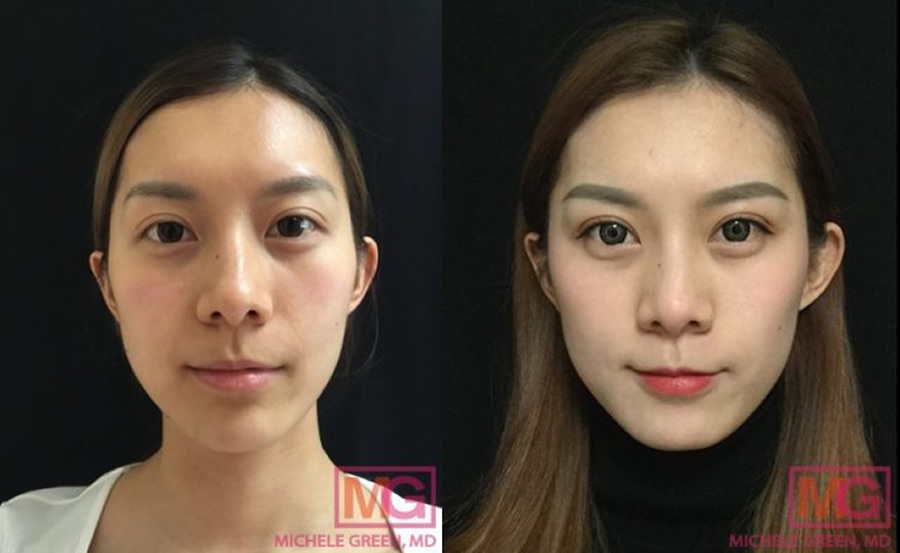
Sculptra 3 months before and after
What is the Best Cheek Filler?
Each filler has its unique uses for the cheeks, preventing one from inherently being better than another. At Dr. Green’s private dermatology office, several different types of fillers are used for cheek augmentation. Dr. Green considers each patient’s unique needs and aesthetic goals to determine which dermal fillers to use in their treatment plan. The most popular cheek fillers include:
Restylane Lyft – Restylane Lyft is a hyaluronic acid-based dermal filler created by the pharmaceutical company Galderma. The product was FDA-approved in 2015 to restore age-related volume loss in the midface. Restylane Lyft is the thickest dermal filler product from the Restylane family of hyaluronic acid fillers, making it ideal for enhancing bone structure, correcting loss of volume, and providing a lifting effect in the cheek area. Dr. Green also uses Restylane Lyft to reduce fine lines and enhance chin and jawline augmentation, as this filler product has a distinct lifting ability often required to rejuvenate the lower face.
Juvederm Voluma – Juvederm Voluma is a hyaluronic acid filler produced by the cosmetic company Allergan. Since 2013, Juvederm Voluma has been FDA-approved to treat loss of volume and fine lines in the mid-face. Dr. Green was among the first dermatologists in NYC to offer Juvederm dermal fillers for facial rejuvenation. Juvederm Voluma is made with Allergan’s patented Vycross technology, resulting in reduced swelling and long-lasting results. In addition to cheek augmentation, Juvederm Voluma is used for chin and jawline enhancement.
Sculptra – Sculptra is a unique, long-lasting dermal filler composed of poly-L-lactic acid, which stimulates new collagen production in the treatment areas, gradually resulting in natural-looking enhancement. Sculptra was originally developed to restore facial volume in patients living with HIV. The facial rejuvenation results were so remarkable that Sculptra was FDA-approved for cosmetic purposes soon after. Typically, a short series of three Sculptra treatments is required, after which the cosmetic effects remain for up to two years. In addition to correcting volume loss in the midface, Sculptra is an excellent dermal filler product for reducing the appearance of acne scars and achieving non-surgical body contouring.
Restylane Contour – Restylane Contour was FDA-approved for cheek augmentation in June 2021. It is made with Galderma’s proprietary XpresHAn technology, which allows for dynamic movement. The XpresHan technology makes Restylane Contour particularly well-suited for rejuvenating the mid-face and cheek area, as the flexibility of the dermal filler provides incredibly natural-looking cheek enhancement.
Radiesse—Radiesse is a dermal filler composed of Calcium hydroxylapatite (CaHA) microspheres. It immediately stimulates new collagen production upon injection, producing a smoother skin texture and restoring volume. Additionally, when the microsphere-containing CaHA gel is injected, healthy, new skin cells grow around the microspheres, resulting in volume enhancement. Radiesse produces long-lasting results, with effects that can remain visible for almost two years following the dermal filler treatment.
SkinVive—Juvederm’s newest FDA-approved dermal filler, SkinVive, is designed to improve skin smoothness and hydration for the cheeks. Like the other Juvederm fillers, Skinvive is an injectable gel composed of hyaluronic acid. However, because of its unique design, Skinvive differs from other dermal fillers in its use to increase skin hydration and smoothness near the injection site. Patients have found their skin smooth and glowing for up to 6 months after treatment.
Consulting an experienced injector for cheek fillers, such as board-certified dermatologist Dr. Michele Green, is critical. Expertise in injection technique, qualities of the various dermal filler products, and facial anatomy are essential to guaranteeing that your cheek filler treatment is safe, effective, and provides optimal facial rejuvenation results. Dr. Green is an internationally renowned cosmetic dermatologist and expert injector who performs precise, customized dermal filler treatments for each patient to ensure the most stunning results, with patient safety and satisfaction as her primary concerns.
Who is a good candidate for cheek fillers?
A good candidate for cheek fillers is a man or woman at least 21 years of age, in overall good health, and seeking cosmetic enhancement of the midface and cheek area. They do not have an allergy to any filler component and are not pregnant or breastfeeding. A good candidate has realistic expectations regarding the facial rejuvenation results that can be achieved with dermal filler injections. Cheek filler treatment is a cosmetic procedure suitable for those looking to enhance the definition of their bone structure, add or replenish cheek volume, or reduce other signs of aging, like fine lines. Breastfeeding and pregnant individuals should not be treated with cheek fillers. You may not be a candidate for cheek filler treatment if you have a bleeding disorder or a history of allergic reactions to dermal filler products. Board-certified dermatologist Dr. Michele Green is an expert injector. During your initial cheek filler consultation at her private dermatology office in NYC, she will collect a thorough medical history and review your aesthetic goals to determine which treatment plan is right for you.
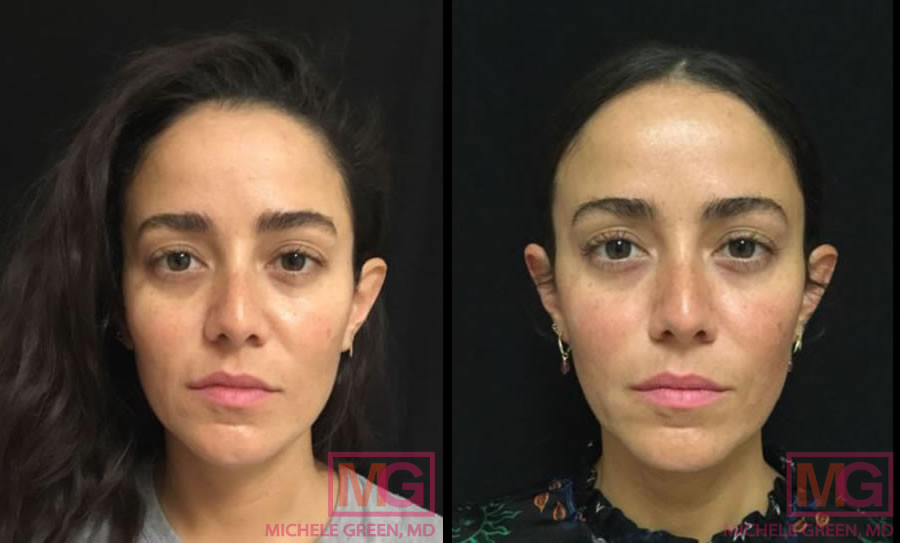
What is the Process of Cheek Filler Treatment?
Cheek filler treatment starts with a consultation with an expert dermatologist, like Dr. Michele Green, in New York City. During your consultation, you will have the opportunity to discuss your specific concerns and ideal aesthetic results. Photos of the treatment area will be taken for your private medical record to enhance your discussion and track future progress. Dr. Green will collect a thorough medical history, review any previous cosmetic procedures you may have had, and physically assess the cheek area and midface. If you are a good candidate for cheek filler treatment, Dr. Green will work with you to develop a timeline for your dermal filler injections.
On the day of your cheek filler treatment, a topical numbing cream should be applied to the midface and cheek area one hour before your injections. Once you arrive at Dr. Green’s dermatology office for your cheek fillers, the numbing cream will be removed and the skin sterilized. Most dermal fillers contain a numbing agent along with the topical numbing, making the procedure pain-free. Dr. Green will artfully perform the cheek filler injections according to your treatment plan. Ice packs will be applied to the injection sites immediately after the dermal filler injections to minimize side effects like bruising and swelling. Dr. Green may re-evaluate the results in two weeks to see if a touch-up is needed.
Where is cheek filler injected?
Cheek filler is often injected into multiple spots along the cheekbones. Fillers injected to improve volume are often placed deep against the bone for the most natural results. Meanwhile, fillers such as SkinVive are injected superficially to hydrate the skin cells. Ultimately, in your initial consultation with Dr. Green, she will review your aesthetic goals and her treatment plan. She will be able to explain further where she will inject the cheek filler for your individualized needs.
What to expect after cheek fillers
When you receive cheek filler with an expert injector like Dr. Green, the process is quick and painless. After the treatment, there are a few mild side effects, so you will be given aftercare instructions. The most common side effects of cheek filler treatment are mild swelling and bruising at or near the injection sites. Swelling in these areas may resemble small lumps or bumps. Should any such bumps be observed after your dermal filler injections, there is no cause for concern as they should resolve independently within 1-2 weeks. Other possible side effects may include bruising of the treatment area, redness, and soreness. In many cases, ice can be used to reduce any swelling or bruising. Depending on the type of filler used, facial rejuvenation results may be observable immediately after the injections (such as with hyaluronic acid fillers) or take longer to develop (as with Sculptra). If you have any questions or concerns after cheek filler treatment with Dr. Green, please don’t hesitate to contact our office.
How long does cheek filler take to settle?
Cheek fillers typically take two weeks to settle fully. When dermal filler “settles,” the filler becomes integrated with the skin tissue in the treatment area, resulting in the final effects of the cosmetic procedure becoming fully visible. In the two weeks it takes the dermal filler to settle, patients may experience mild side effects, such as swelling, redness, and bruising at or near the injection sites. However, these side effects will resolve within one to two weeks of the filler treatment.
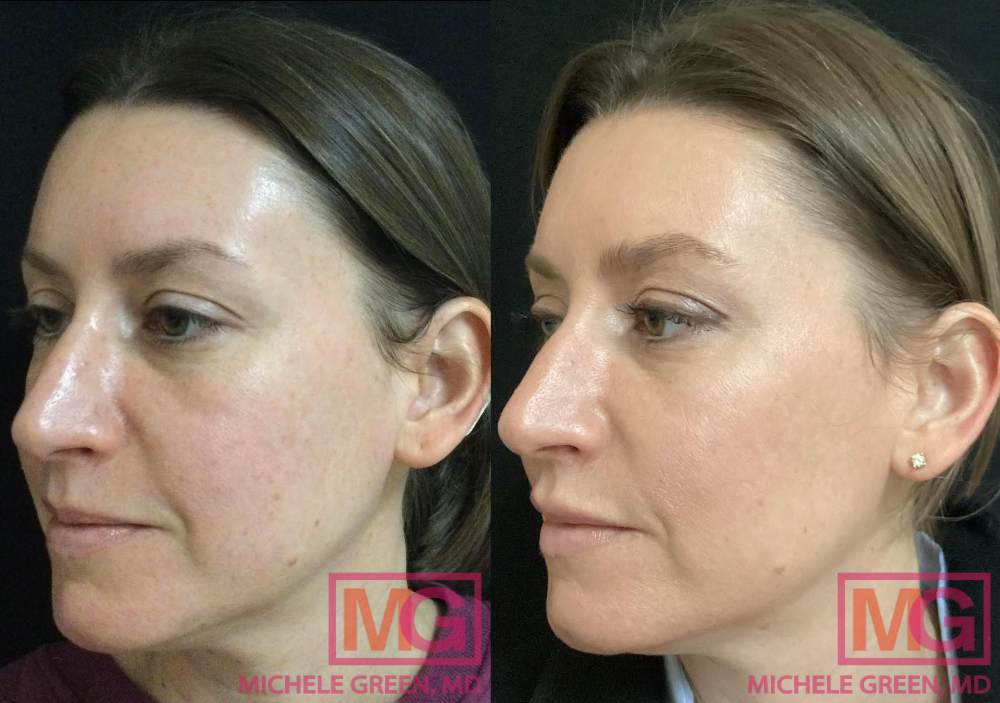
Juvederm Ultra Plus – 1 syringe, and Voluma – 2 syringes: 2 months before and after
How long does cheek filler last?
On average, cheek fillers produce facial rejuvenation results that last six months to 2 years. The type of fillers used plays the biggest role in determining the longevity of the results. Additionally, the amount of filler used for your cheek augmentation will impact the longevity of the results. When you receive filler from a skilled injector, they will be able to set expectations for you. Most patients with hyaluronic acid cheek filler treatments, Juvederm or Restylane, receive maintenance injections semiannually or annually for consistent results. Sculptra and Radiesse are dermal filler products with results lasting up to two years. Although these cheek fillers are somewhat longer lasting, many patients still have annual treatment sessions, as Sculptra and Radiesse are collagen stimulators that produce gradual facial rejuvenation results. When you consult with board-certified dermatologist Dr. Michele Green at her private NYC office, she will help you establish a schedule for cheek filler treatment sessions that suit your particular needs and goals.
How long does Juvederm last in the cheeks?
Depending on the filler you receive, your Juvederm can last from 6 to 12 months. Juvederm Voluma and SkinVive each have unique compositions and functions. Voluma has an average duration of 2 years in the cheeks, while SkinVive is only expected to last up to six months. While SkinVive is growing in popularity, Voluma is the most common Juvederm filler used on the cheeks. When you consult with Dr. Green, she will be able to inform you of the duration of your filler treatment.
How long does Juvederm Voluma last in the cheeks?
One of the most popular cheek fillers, Juvederm Voluma, is expected to last for one year in the cheeks. Dermal fillers are naturally metabolized by the body, so their results are temporary. For one year, patients can expect fuller, smoother cheeks. Many patients opt for annual maintenance treatments for continuous, beautiful results.
What to do after cheek fillers are injected?
After receiving cheek filler treatment from Dr. Green, patients will be given aftercare instructions, which they should follow to achieve ideal results. The specific aftercare instructions may vary depending on the type of dermal filler used for your cheek augmentation. Hyaluronic acid dermal filler injections have slightly different aftercare instructions than cheek fillers made of other substances like poly-L-lactic acid (Sculptra). For example, treatment areas injected with Sculptra must be massaged several times a day for several days. Massaging Sculptra ensures even product distribution and induces collagen production equally throughout the treatment area. On the other hand, hyaluronic acid cheek fillers do not need to be massaged for optimal results. In addition to following the aftercare protocol, Dr. Green may ask you to return two weeks after your initial cheek filler treatment so she can evaluate the results and determine if any touch-up is required.
What not to do after cheek fillers are injected?
After receiving cheek filler, you should refrain from applying makeup or touching the injection sites for at least 24 hours, avoid strenuous exercise for 48 hours, abstain from alcohol consumption for several days, discontinue blood-thinning medications or supplements for several days, and avoid putting pressure directly on the treatment area. Applying makeup or touching the area can increase the chances of infection, while exercise, alcohol, and blood-thinning medications increase the chance of bruises developing. Dr. Green will provide all the pertinent aftercare information required for achieving and maintaining ideal cosmetic results, depending on the specific type of filler used. If you have any specific questions or concerns regarding the aftercare protocol for your cheek filler treatment, be sure to discuss them with Dr. Green during your appointment.
Can you use skincare and makeup after cheek fillers?
While you can return to most of your regularly scheduled activities immediately after filler treatment, Dr. Green recommends waiting several hours before applying makeup or other skincare products, such as lotion or sunscreen. To reduce the risk of infection, it is important to keep the skin clear and dry after cheek filler treatment. Because fillers are injections that penetrate the skin, applying products may introduce bacteria into the injection sites, which can result in an infection. If you believe your injection site has become infected, inform your medical provider immediately, as you may need to start antibiotics.
Can you exercise after cheek fillers?
Dr. Green recommends refraining from strenuous exercise and other activities that raise your body temperature for 48 hours after cheek filler treatment to prevent worsening swelling at the injection sites and reduce the risk of infection. So, patients are advised to avoid using saunas and steam rooms for 48 hours after their cheek filler treatment. After 48 hours, you can return to your regular exercise and recovery routine when the highest risk of infection, swelling, and bruising has passed.
How to sleep after cheek fillers
Following dermal filler treatment, avoiding putting pressure directly on the treatment area is important. Rubbing or massaging the injection site can increase the risk of hyaluronic acid filler migration, potentially decreasing the treatment’s effects and possibly leading to more serious side effects. As such, Dr. Green recommends sleeping on your back in the days following the cheek filler treatment to avoid putting too much pressure on the cheek area when you sleep. Sleeping on your side increases the risk of filler migration, making your results look uneven.
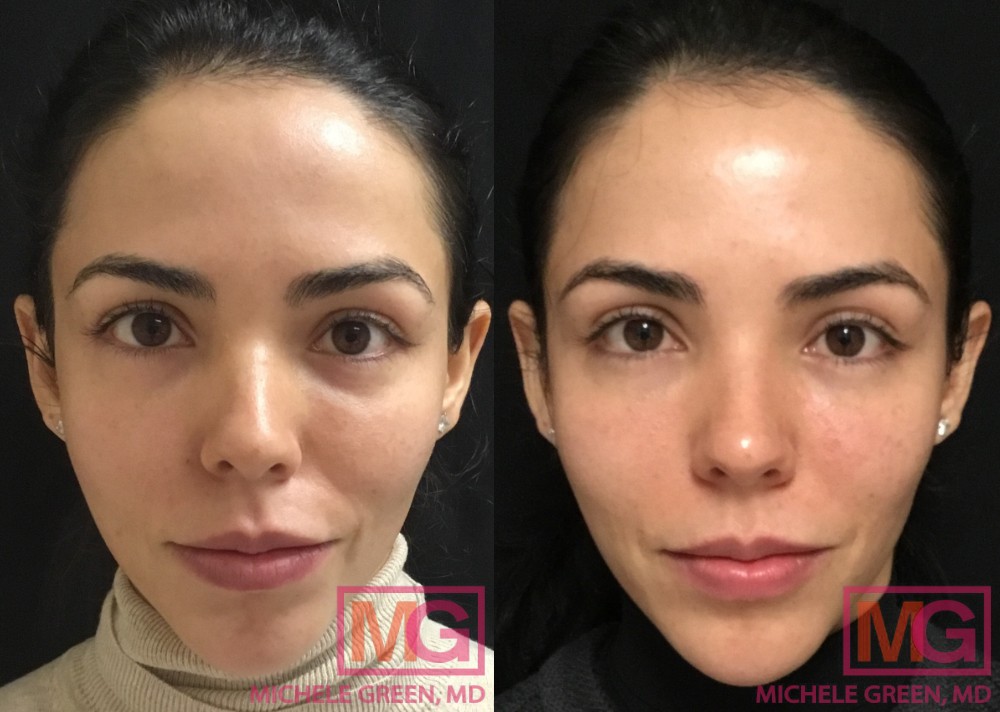
How many syringes for cheek filler?
Typically, patients receive between 2-4 syringes, about 1-2 mL per cheek, of dermal fillers for their ideal cheeks. The amount of cheek filler needed for a given patient will vary depending on their face shape, the type and severity of the skin concerns being addressed, their aesthetic goals, and the type of filler used. During your initial facial rejuvenation consultation with Dr. Green, she will physically assess the treatment area and determine what type of filler and approximately how much cheek filler will be needed for your goals. Cheek filler treatment is temporary, and most patients have maintenance treatments of dermal filler injections for the best effects.
How often should cheek fillers be redone?
While the longevity of your cheek fillers will vary depending on the amount and type of filler used for your treatment and your individual metabolism, it is best to maintain your cosmetic results with regular filler appointments. Most patients engage in a “touch-up” treatment annually to maintain optimal facial rejuvenation results. These maintenance appointments are also beneficial for Dr. Green to reevaluate your face and make any necessary adjustments to your treatment as your needs and goals evolve over time.
Does cheek filler improve the jawline? Do cheek fillers lift jowls?
Yes! Having cheek filler treatment can improve the appearance of sagging jowls along the jawline. By adding volume to the cheeks, the sagging skin is lifted, which can improve skin laxity of the lower face. While injecting the cheek area with dermal fillers can help provide the lower face with a lifted appearance, patients should not rely on cheek filler treatment alone to correct the appearance of skin laxity in the lower face- including sagging jowls. For patients concerned about skin laxity, Dr. Green often recommends combining their cheek filler treatment with a skin-tightening procedure, the most popular option being the Thermage. Thermage is the gold standard cosmetic procedure for non-surgical skin tightening. A single treatment session results in firmer, smoother, tighter skin, with results lasting up to two years.
Do cheek fillers help nasolabial folds?
Nasolabial folds, also known as laugh lines or smile lines, are wrinkles from the side of the nose down to the corners of your mouth. Deep nasolabial folds may be genetic or develop due to decreased collagen and elastin production, causing the skin to lose structure and wrinkles to become etched into the skin. Fortunately, dermal fillers can reduce the appearance of nasolabial folds. In fact, nasolabial folds are one of the most common signs of aging to be treated with dermal filler injections. Similar to jowls, cheek fillers can improve nasolabial folds; however, for the best results, Dr. Green often pairs cheek fillers with fillers injected directly into the nasolabial folds.
Does cheek filler help under eye bags?
Depending on the anatomy of the undereye hollows, cheek filler may improve the appearance of undereye bags. Cheek fillers can be placed in a way that reduces the visibility of deep creases that can cast shadows beneath the eyes, resulting in a rejuvenated undereye appearance. Injecting a hyaluronic acid filler into these depressions can provide the volume needed to erase the shadow underneath the eyes and result in a revitalized, rejuvenated, more youthful appearance. If the eye bags are present due to excess skin, injecting dermal filler into the area can worsen their appearance. Patients with undereye bags caused by excess skin in the area would benefit most from plastic surgery to remove the skin. For this reason, it is essential to consult with a board-certified dermatologist, like Dr. Michele Green in New York City, who has the expertise and experience to discern whether or not you are an appropriate candidate for cheek fillers to correct the appearance of under-eye bags. Many patients treat under-eye bags with filler to the tear troughs just above the cheeks. However, not everyone is a candidate for filler here. If you are not a candidate for undereye dermal filler injections, Dr. Green will refer you to a trusted board-certified plastic surgeon for a consultation.
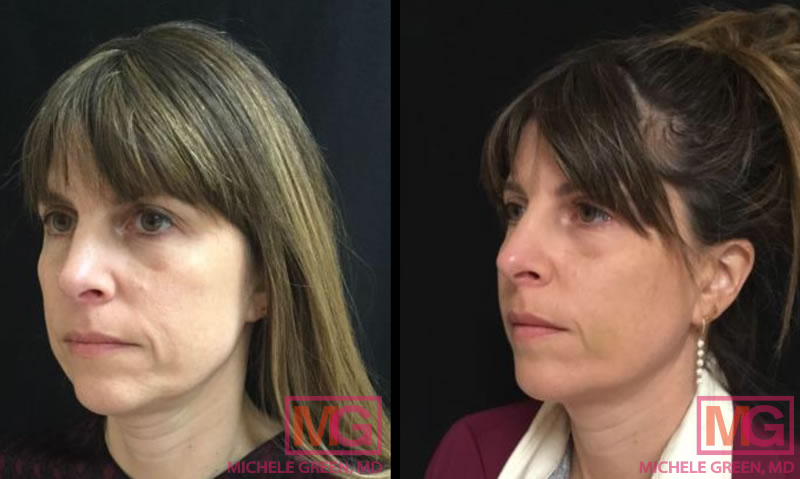
Thermage with Voluma and Restylane Lyft
Do cheek fillers lift your face?
Cheek fillers lift the midface and replenish cheek volume, creating a more youthful appearance. By adding back lost volume, fillers can boost up sagging skin around the mid and lower face. Cheek fillers also enhance the definition of the bone structure and provide a smoother skin texture. While the facial rejuvenation effects of cheek filler treatment will not be as dramatic as that of a surgical facelift, patients enjoy the fact that their cheek fillers are customizable, can be adapted to their evolving aesthetic tastes over time, and require little, if any recovery time. When you consult with Dr. Green regarding cheek enhancement, you can discuss your personal aesthetic goals, and she will inform you whether cheek filler treatment will provide you with the lift you want or whether another cosmetic procedure would be better suited to the facial rejuvenation results you seek.
Combining cheek fillers with other non-invasive cosmetic procedures
Dermal fillers are an excellent treatment option for the enhancement of facial contours, the augmentation of certain features, the replenishment of volume loss, and the provision of a more youthful appearance. Dermal fillers are a non-invasive cosmetic procedure and a popular alternative to plastic surgery due to the consistently stunning facial rejuvenation results, lack of downtime, and ease of injections. Dermal filler injections can easily be paired with other non-invasive cosmetic procedures to achieve a non-surgical facelift. Many patients interested in cheek enhancement may show other signs of aging, such as dynamic fine lines, pigmentation issues, skin laxity, or sun damage. Dr. Michele Green offers an array of non-invasive cosmetic procedures at her private dermatology office. She will work with you to develop a personalized treatment plan for your cosmetic concerns. The most common procedures paired with fillers are Botox injections, Fraxel, and Thermage treatments.
Botox is the gold standard for preventing and eliminating dynamic wrinkles. Dynamic fine lines are those that form over time due to repetitive facial expressions, most commonly affecting the skin of the upper face, glabella (between the brows), forehead, and crow’s feet. Botox can also be used to slim the face and treat TMJ (temporomandibular joint pain). Botox is an injectable neurotoxin that ‘freezes’ targeted facial muscles, preventing their contraction and resulting in a smoother skin texture. The effects of Botox take up to two weeks to kick in and last for up to four months. Most patients have Botox injections every 3-4 months to maintain the best effects. Dr. Green is an Allergan platinum injector, providing what has been described as the “best Botox injections in New York.” Many patients have Botox and dermal filler injections during the same appointment to target age-related and dynamic fine lines and the volume loss of their cheeks.
Fraxel is a skin resurfacing laser treatment often referred to as the ‘magic eraser’ by Dr. Green for its unique ability to target a wide range of skin concerns. The Fraxel Dual laser used by Dr. Green operates on two distinct wavelengths of light. Fraxel relies on fractional laser technology to stimulate new collagen production in the treatment areas and improve skin texture and tone. Since the skin’s surface is left intact, minimal downtime is involved, with most patients experiencing mild side effects like swelling, redness, and tenderness in the treatment area for about two days. Most patients require three treatment sessions, each spaced one month apart, to achieve optimal facial rejuvenation results with Fraxel.
Thermage is the gold standard for non-invasive skin tightening. This laser treatment relies on radiofrequency energy to stimulate new collagen production, resulting in smoother, firmer, tighter skin. There is zero downtime involved with Thermage, meaning patients can resume their normal daily activities immediately after the procedure is complete. In addition to treating the midface, Thermage can be used to improve skin elasticity in the lower face, neck, chest, decolletage, upper arms, abdomen, thighs, and buttocks. The effects of Thermage last up to two years, with most patients engaging in an annual maintenance treatment to keep up the best effects.
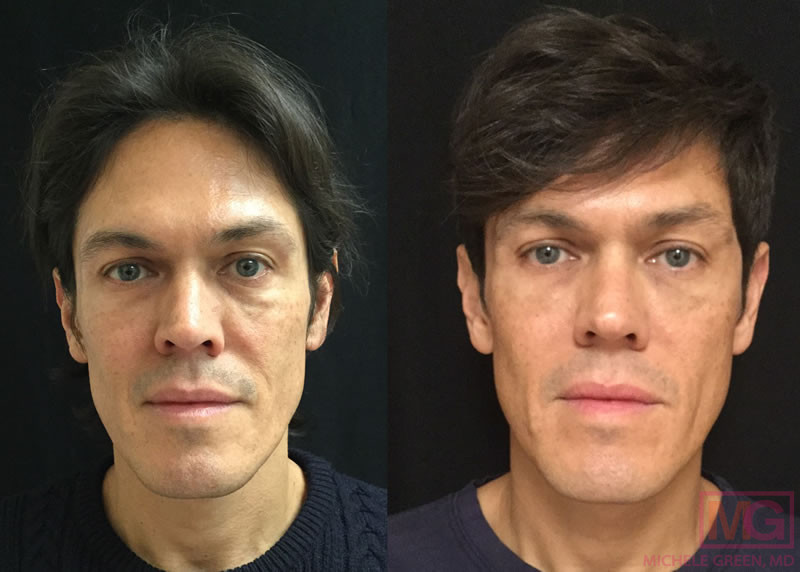
Are cheek fillers safe?
Yes! Cheek fillers are a safe and effective non-surgical cosmetic procedure for facial rejuvenation when dermal filler injections are performed in a medical setting with a board-certified dermatologist, such as Dr. Michele Green, in New York City. The dermal filler treatment process is straightforward for an experienced and knowledgeable injector like Dr. Green. The risk of encountering unwanted side effects or poor cosmetic results increases when having filler treatment in a medical spa setting or elsewhere outside the office of a board-certified dermatologist or plastic surgeon. A thorough anatomical understanding is essential, as serious negative side effects, such as injection into a blood vessel, can occur otherwise. Dr. Green is a board-certified dermatologist with over 25 years of experience providing her patients with the best non-surgical cosmetic procedures for beautiful, natural-looking, long-lasting facial rejuvenation results. When you choose to work with an expert injector like Dr. Green, you guarantee that your dermal filler treatment is centered around patient safety and satisfaction.
Are cheek fillers dangerous?
Overall, treatment with cheek fillers is a very safe procedure for most people. However, you should not get filler if you are pregnant, breastfeeding, or allergic to any ingredients. As such, sharing your complete medical history with your injector is important. When you have dermal filler treatment with an experienced board-certified dermatologist, such as Dr. Green in NYC, the procedure is a safe and effective option for non-surgical rejuvenation. Having dermal fillers with an expert injector significantly reduces the risk of encountering adverse events and unwanted side effects. The most common side effects of cheek fillers include mild swelling, bruising, and tenderness at or near the injection sites, which typically resolve independently shortly after injections. More serious side effects can occur when an inexperienced or unqualified injector performs cheek filler treatment. For example, the inadvertent injection of dermal filler into a blood vessel can cause side effects such as blindness, stroke, and necrosis of skin tissue.
Do cheek fillers swell or bruise?
Mild swelling and bruising at or near the injection sites is a potential side effect of cheek filler treatment. This side effect typically resolves on its own shortly after dermal filler injections but can take up to two weeks to subside completely. Once the dermal filler injections are finished, ice packs are applied directly to the treatment area to minimize swelling. Patients can reduce their risk of bruising by avoiding alcohol consumption and refraining from taking blood-thinning medications or supplements in the week before and after their cheek filler treatment. Dr. Green asks that her patients treated with dermal fillers return to her NYC office for a follow-up appointment once they have fully settled for her to evaluate the results, determine whether or not any touch-ups are required, and plan the next appointment for maintenance should any be needed.
How to reduce swelling and bruising after cheek filler treatment
One of the best ways to reduce swelling after dermal filler injections is directly applying an ice pack to the treatment area immediately after the cosmetic procedure. When you have cheek filler treatment with Dr. Green at her private dermatology office in Manhattan’s Upper East Side neighborhood, ice packs will be applied to the area to minimize initial swelling. A cold compress can be used intermittently following the filler treatment as the patient desires for their comfort. Strenuous exercise should be avoided for at least 48 hours following cheek filler treatment, as increasing one’s body temperature can worsen swelling near the injection sites and increase the risk of infection. In the same nature, warm showers are preferable over hot showers.
Dr. Green recommends that patients take Tylenol for pain relief in the two weeks before and after their cheek filler treatment rather than use pain medications such as Ibuprofen or Advil, which are blood thinners and may worsen the potential side effects of swelling and bruising. It is also advised to avoid other blood-thinning vitamins, supplements, and medications to minimize swelling and bruising. Arnika Forte is an herbal supplement that can be used topically or orally to help further prevent bruising and swelling. It is available at Dr. Green’s dermatology office or can be purchased over the counter at your local pharmacy.
Does cheek filler migrate?
Filler migration is an exceptionally rare side effect in any case of dermal filler injections. Cheek filler, in particular, is less likely to migrate than dermal fillers placed in areas of the face such as the lips and under-eyes. Dermal filler migration is most likely to occur when an inexperienced or unqualified injector performs the injections. Using too much dermal filler product or an inappropriate injection technique may result in dermal filler migration. For this reason, it is imperative that your dermal filler injections are done by a board-certified dermatologist who has both the experience and expertise required to provide optimal results, such as Dr. Green in New York.
If you’ve had hyaluronic acid fillers that have migrated, resulting in asymmetry, nodules, or another poor cosmetic result, Dr. Green can dissolve the dermal filler product with hyaluronidase injections. Hyaluronidase is an enzyme that breaks down hyaluronic acid and can be used to reverse the effects of HA filler treatment. Sometimes, more than one session of hyaluronidase injections may be required, depending on the amount of dermal filler initially injected (more dermal filler product needs a greater amount of hyaluronidase to dissolve fully).
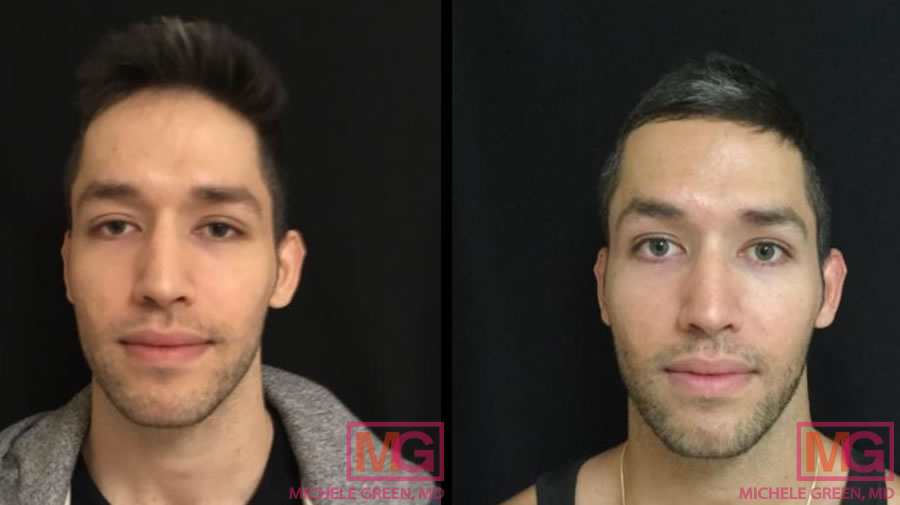
Sculptra and Restylane – 4 months
Can cheek filler migrate to the under eye area?
In the rare case where cheek filler migrates, it can relocate to multiple locations in the face, including the under eyes. Overfilling or incorrect technique may result in dermal filler migration. To reduce risks, you should only receive filler from a board-certified plastic surgeon or dermatologist, like Dr. Michele Green in New York.
Do cheek fillers hurt?
No, the process of having dermal filler injections is quick and relatively painless. The injectable fillers used by Dr. Green at her private dermatology office in NYC are compounded with lidocaine, a local anesthetic, to enhance patient comfort during the filler treatment. Additionally, Dr. Green prescribes a topical numbing cream that should be applied to the entire treatment area one hour before dermal filler injections. Once you arrive at Dr. Green’s office in the Upper East Side, the numbing cream will be removed and the skin sterilized in preparation for the dermal filler treatment.
How much does cheek filler cost?
Cheek augmentation with dermal filler can range in price greatly depending on several contributing factors. The total cost of your cheek filler treatment will be influenced by the amount of dermal filler product needed and the type of filler selected. Other factors that influence the total cost include the geographic location of the medical office where you are treated and the experience level of your injector. When you work with Dr. Green, she will create a custom facial rejuvenation treatment plan that balances your budget with your desired cheek augmentation outcome. After your initial consultation, Dr. Green’s office will be able to provide you with a more accurate estimate of the treatment cost based on your treatment plan. Generally, dermal filler injections for cheek augmentation range from $1,000 to $2,000. The cost is competitive compared to surgical cheek augmentation, which can cost upwards of $10,000, not including other fees like anesthesiology, which can make the procedure much more expensive.
Is cheek filler worth it?
You may wonder if cheek fillers are worth it for your goals and budget. For many patients, they are. A surgical facelift is much more expensive and has long downtime, while cheek fillers are cheaper and have no associated downtime. The consistently stunning results make this one of Dr. Green’s most common procedures in her private dermatology office. While temporary, cheek fillers have long-lasting results, some lasting for two years, making them worth it for many patients.
Why do people get cheek filler?
People get cheek fillers for a myriad of reasons. The most common reason is that they struggle with flat cheekbones and volume loss and desire more pronounced cheeks without downtime. As we age, our skin naturally loses collagen, which can lead to sagging and wrinkles. A quick, non-invasive solution is cheek fillers.
What does cheek filler look like?
When an expert injector like Dr. Green performs your cheek filler treatment, the result is a firmer, smoother skin texture and a subtle, youthful fullness. Cosmetic enhancement with dermal fillers should not be obvious or overdone. It should be difficult to tell if someone has cheek fillers if you are not a professional injector. If the dermal filler injections are poorly performed, patients may observe facial asymmetry, persistent puffiness or swelling, or an unnatural appearance.
Should I get cheek fillers?
Cheek filler treatment is a great cosmetic procedure to reduce fine lines, enhance bone structure, or restore volume to the midface area. Dr. Green can help you determine a facial rejuvenation treatment plan suited to your facial structure and cosmetic goals. Should you decide that cheek filler treatment is something you want to do, Dr. Green offers several different filler products to ensure you get the most natural-looking, long-lasting, optimal results. There are minimal side effects associated with cheek filler treatment and zero downtime. If you are unsure whether or not you should get cheek fillers, schedule a consultation with Dr. Green, an expert injector who can recommend the combination of treatments that will serve you best so that you’ll look and feel like the best version of yourself.
How do I get started with cheek fillers today?
With so many options for cheek filler, getting started can be overwhelming. The first step in getting started with cheek filler is to meet with an expert injector who can select the best cheek filler for your facial anatomy and aesthetic goals. Many fillers are used for cheek augmentation, each with a unique composition and skin benefits. This allows for a completely customizable approach and long-lasting, natural-looking results. An experienced injector like Dr. Michele Green in NYC will use an individualized approach, taking advantage of the unique composition of each filler.
Dr. Michele Green is an internationally renowned board-certified dermatologist with over two and a half decades of experience providing some of the globe’s most discerning individuals with the best non-invasive cosmetic procedures, including cheek fillers. Dr. Green takes a holistic approach and embraces a less-is-more philosophy regarding cosmetic procedures, customizing each patient’s treatment plan best to suit their particular skin concerns and aesthetic goals. She is consistently identified as one of New York’s best physicians by Super Doctors, Castle Connolly, and New York Magazine for her dedication to her patients and expertise. To start your non-invasive facial rejuvenation journey and learn more about cheek filler treatment, schedule a consultation with Dr. Green by contacting us online or calling the office at 212-535-3088.
 212-535-3088
212-535-3088